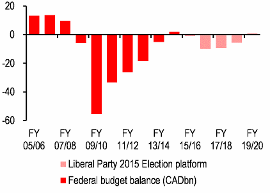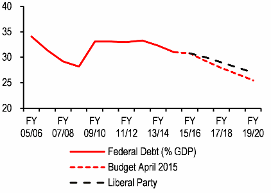
One economist’s look at the 2015 federal election
by David Watt, Chief Economist at HSBC Bank Canada

Chief Economist at HSBC Bank Canada David Watt crunches the Liberal's numbers in the wake of the party's stunning majority election win
TORONTO—A key plank of the Liberal platform is to increase infrastructure spending in part by running budget deficits between the 2016-17 and 2019-20 fiscal years.
In our view, the fiscal lift is rather modest and, amid a still challenging economic outlook, continues to leave room for further monetary policy stimulus.
Implications
The Liberal party deviated from the other major parties in pledging to run deficits totalling $25 billion over the next three fiscal years. The Conservatives and NDP both proposed balanced budgets. Figure 1 presents the outlook for the budget balance under the Liberal’s fiscal plan.
In the chart, the budget is expected to have a $1 billion deficit in 2015-16. This is based on projections from the Parliamentary Budget Office that are discussed in more detail below.
Despite the deficit plan, the Liberals also project that the federal debt-to-GDP ratio will fall to 27 per cent in coming years (see figure 2). The debt-to-GDP ratio is thus set to decline at a slightly slower pace than that projected by the Conservative Party in the April 2015 Budget. Even though the Liberals propose deficits in coming years, they do not set a definitively different fiscal track than those proposed by the other major parties. Note that the last time the Liberals were the governing party, they ran persistent fiscal surpluses. There are several elected members from the last time the Liberals ruled to help steer the new federal government on a prudent fiscal path.
Figure 1: The Liberal Party plans to run budget deficits for the next few years.

Sources: Department of Finance, Parliamentary Budget Office, HSBC
Figure 2: Federal debt-to-GDP ratio is still set to decline

Sources: Department of Finance, Liberal Party of Canada, HSBC
The Liberal plan calls for increased infrastructure spending of more than $5 billion in 2016-17 and 2017-18. The details of the program have not been released.
To fund their spending initiatives the Liberals plan to unwind some of the Conservative’s tax measures, such as revamping the child benefit programs,
raising taxes on wealthier Canadians, cancelling income splitting for families with young children, cancelling the $4,500 increase in Tax Free Savings Accounts and to conduct a review of current program expenditures.
The Liberals also plan release up to $6.5 billion in funds for other initiatives by cutting the government advertising budget, and reviewing the proliferation of boutique tax measures that have added complexity to the tax code in recent years.
On the corporate front, the small business tax credit is set to be reduced to nine per cent from 11 per cent.
Fiscal stimulus and the Bank of Canada
The backdrop will be an economy that faces greater challenges than had been anticipated in the Liberal platform. Pay particularly close attention to the Bank of Canada’s Monetary Policy Report due Oct. 21. We expect the Bank to release more cautious outlooks for this and subsequent years. To us, this will still leave room for further monetary policy action despite potential Liberal fiscal policy stimulus.
Consider that the Parliamentary Budget Office used the Bank of Canada’s July economic projections to project that federal budget surpluses would be much smaller than those projected in the April 2015 Budget. Thus, while the federal government projected surpluses totalling $5.7 billion between 2015-16 and 2017-18, the PBO projected surpluses totalling just $1.8 billion. Those projections were based on real GDP growth averaging 2.0 per cent over next three years.
We have a more cautious view on the outlook for the economy, forecasting GDP growth to average 1.7 per cent over the next three years. While we do not doubt that the economy could use supportive fiscal policy, we don’t see the modest Liberal program that is currently proposed as enough. Thus, we continue to see monetary policy as playing an important role in supporting growth and the “rebalancing” of the economy from oil and energy toward non-energy sectors.
Known unknowns
There are also still some important unknowns as the Liberals take over. First, the Liberals have been very careful in their discussions of the Trans Pacific Partnership. Overall, we expect that despite some possible trepidation, the Liberals will use the weight of their majority to support the trade deal.
Second, the Liberals have not discussed their approach to the housing sector. The Conservative Party had indicated that it planned to make it easier to use retirement savings to enter the housing market, introduce a permanent home renovation tax credit, and to boost the home ownership rate to 72.5 per cent by 2020. In our view, the next government should shift its focus toward considering appropriate economy-wide measures to lower the risks to financial stability from the housing market.
Third, we would like to see more clarity on an innovation agenda. The Conservative Party touted an advanced manufacturing hub for Burlington, Ont. Such a hub could help assume some of the risk of small firms adopting advanced technologies by giving them access to skills and financial expertise that they might not possess. We see this hub as a very good proposal and as potentially very important to help improve Canada’s generally lacklustre history of productivity growth.